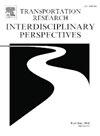Predictable motorway ramp curves are safer
IF 3.8
Q2 TRANSPORTATION
Transportation Research Interdisciplinary Perspectives
Pub Date : 2025-07-01
DOI:10.1016/j.trip.2025.101522
引用次数: 0
Abstract
Motorway safety depends largely on curve geometry and driver behaviour, a relationship that has implications for research and practice. This paper introduces a novel approach to quantifying geometric design consistency, defined as the degree to which drivers’ expectations of curve radii match actual road geometries. The hypothesis is that if a driver expects a larger curve than that actually present, an accident might occur because of an excessively high approach speed. To test this hypothesis, this study uses Dutch motorway data, including ramp and curve characteristics, as well as crash frequencies. The data were employed in three steps: 1) constructing a Bayesian model that mimics drivers’ expectations, 2) testing the predictions of this model against real curve characteristics, and 3) examining the relationship between disparities in expectations, reality, and crash frequency. The results indicated a positive correlation between disparities in expectations, reality, and crash frequency. This finding suggests that the crash frequency is higher when drivers expect a larger curve than what is present. The Tree Augmented Naïve Bayesian Network (TAN) reveals the complexity of curve expectations, demonstrating that drivers anticipate larger radii in connector ramps and higher speeds with gentler curve angles. Applying this research to motorway design involves using TAN predictions and crash frequency models to assess safety in motorway curve design, which could proactively improve road safety.
可预测的高速公路坡道曲线更安全
高速公路的安全很大程度上取决于曲线的几何形状和驾驶员的行为,这种关系对研究和实践都有影响。本文介绍了一种量化几何设计一致性的新方法,定义为驾驶员对曲线半径的期望与实际道路几何形状的匹配程度。假设是,如果司机预期的弯道比实际存在的弯道大,事故可能会因为过快的接近速度而发生。为了验证这一假设,本研究使用了荷兰高速公路的数据,包括坡道和弯道特征,以及碰撞频率。数据的使用分为三个步骤:1)构建一个模仿驾驶员期望的贝叶斯模型,2)根据实际曲线特征测试该模型的预测,3)检查期望、现实和碰撞频率之间的差异。结果表明,期望、现实和碰撞频率之间的差异呈正相关。这一发现表明,当司机预期的弯道比实际情况更大时,撞车的频率会更高。Tree Augmented Naïve贝叶斯网络(TAN)揭示了弯道预期的复杂性,表明驾驶员期望连接器坡道的半径更大,弯道角度更平缓时的速度更高。将本研究应用于高速公路设计,包括使用TAN预测和碰撞频率模型来评估高速公路弯道设计的安全性,从而主动提高道路安全性。
本文章由计算机程序翻译,如有差异,请以英文原文为准。
求助全文
约1分钟内获得全文
求助全文
来源期刊

Transportation Research Interdisciplinary Perspectives
Engineering-Automotive Engineering
CiteScore
12.90
自引率
0.00%
发文量
185
审稿时长
22 weeks
 求助内容:
求助内容: 应助结果提醒方式:
应助结果提醒方式:


